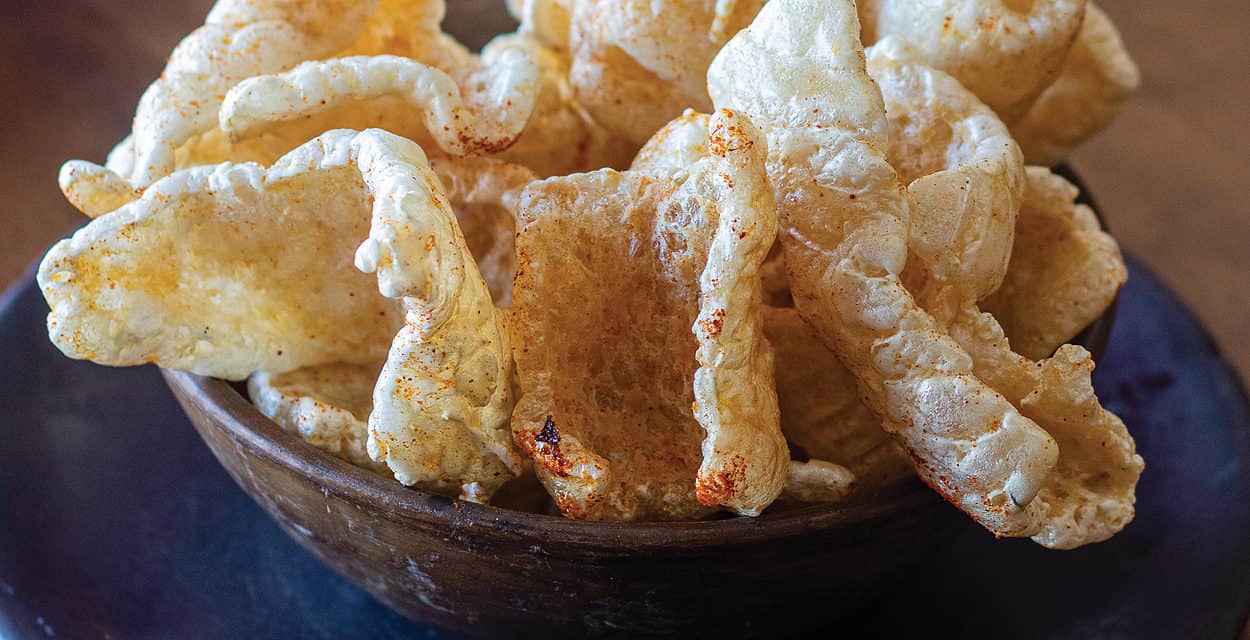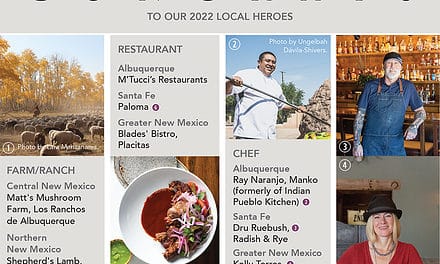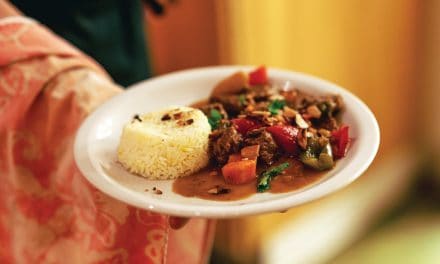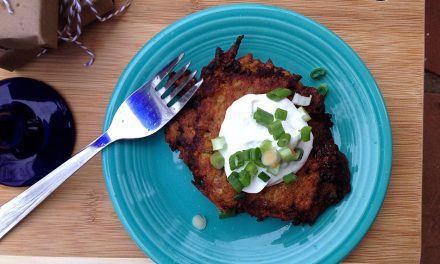
I remember the chicharrones.
El Paso. Childhood memories of spending the weekend downtown in the Big City with my mother, Delfina, and her sister, Lucia, from El Polvo / The Dust, Texas, a town of fifty people. We had adjoining rooms with a shared bathroom at the McCoy Hotel next to the Plaza Theatre.
The Plaza Theatre was at the northern end of El Paso Street, near the Plaza de Lagartos, where live alligators lounged in a fountain until one day the moat was breached by a rowdy Fort Bliss soldier.
The Plaza Theatre with its luxurious and ornate decor was the height of opulence to us. Only several blocks away toward the Santa Fe bridge leading into Juárez was El Teatro Colón, the venerated movie theater where Mexican movie stars like Pedro Infante and Tin Tan inscribed their names on a wall in the basement dressing room.
El Paso was life. Excitement. Potential. It carried the history of our people as they traveled back and forth between the two worlds of La Frontera—the United States and México.
El Paso is a place of beautiful contrast. Color. Constant surprise. You can buy vials of ginseng and twisted bamboo plants in the shops, Our Lady of Guadalupe throws, or Emiliano Zapata T-shirts. You can eat Chinese or Korean food with a Mexican twist or Mexican food with a Lebanese flavor. Languages move fluidly and once I overheard a woman say in French, “Are we still in the US?” Immigrants were and still are part and parcel of these neighborhoods. The area has always been a food haven, a rich multicultural blending.
Recently I ordered chicharrones at Elemi in downtown El Paso on Kansas Street. Not quite El Paso Street, but close enough to hold the memory of walking and shopping on these inner-city streets of the El Paso I know so well.
The chicharrones arrived, still crackling. The sound of the freshly fried pork skins reminded me of the chicharrón place I once loved so much. A few blocks south of the Plaza Theatre, just before El Colón, the restaurant had a large picture window where you could see giant sides of pork skins hanging on hooks, rows of chickens roasting in the background.
Looking at the generous, still-sizzling chicharrones at Elemi, I held the memory of those halcyon days with my mother and her sister sitting together at a humble table sharing plates of chicharrones. I have forgotten or never knew the name of the place, but when we were together, we were familia. Our histories were forged on La Frontera of El Paso del Norte, our break between the Worlds, on the streets of memory and love.
I am a vegetarian except for chicharrones. The flavor of the tasty pork is in my blood. From early days of roasting pigs at family feasts, weddings, anniversaries, the taste of chicharrones, las de deveras, the real ones with just enough fat to make it all worthwhile, will always be a part of me. It’s hard for me to pass by a supermarket aisle with endless bags of pork skins. My spiritual bent tells me to eschew pork, but I can’t seem to stay away too long from this food of memory and home.
Elemi, owned and run by Chef Emiliano Marentes and his wife, Kristal, is all things El Paso to me. It is all things Frontera. It is all things sacred and Mexicano and meaningful to me, a child of the Border. In this rich background of culture and music and art, food reigns. The name is an abbreviation of El Emiliano—El Emi—and not the elemi tree from the Philippines that is known for its amber resin used in lacquer work.
Both Chef Emiliano and his wife grew up nearby, in the area called El Segundo Barrio, a historic and rich area next to Ciudad Juárez, our sister city, our other homeplace.
El Segundo Barrio has a rich history. Home to many immigrants, it has always been a haven of culture and art, as well as a place of continuing struggle and domination by those who legislate borders. It was the site of battles in the Mexican Revolution with spectators peering down from rooftops to view street skirmishes below. It is famous for Teresa, La Santa de Cabora, who was, for a brief time, a resident of El Paso. She was the Mexican American mystic whose followers sought healing in these streets.

From top left, clockwise: Huarache with green chorizo, nopales, black bean puree, seasonal radish, pea tendrils, arugula, red onion, and queso fresco; Aguachile de Callo de Hacha with scallops, aguachile verde, avocado, radish, and cucumber; Taco Suadero with confit Angus beef skirt, salsa de aguacate, and onion-cilantro; Campesino Vegetarian with cremini mushrooms, grilled eggplant, Oaxacan black beans, grilled avocado, and caramelized quesillo.
El Paso is also the birthplace of many seminal Chicano and Chicana authors and artists, including Ricardo Sánchez, Abelardo Delgado, Óscar Zeta Acosta, Alicia Gaspar de Alba, and Estela Portillo Trambley, the first Chicana playwright, and many others who found their voice and spirit in these often-segregated streets that were the birthplace of our empowerment and hope.
I once asked our then Las Cruces bishop, Ricardo Ramírez, what I should be writing about. He told me to write about the farmworkers from Juárez and the surrounding areas who left their homes at two in the morning to be driven in cattle cars to the New Mexico chile fields, their day ending in the late afternoon. They often arrived home at dark, repeating the same thing the next day. To work “los files” (the fields) is very hard work.
Downtown El Paso is where Chef Emiliano’s father, Carlos Marentes, continues to organize farmworkers. Señor Marentes is the director of The Centro de Trabajadores Agrícolas Fronterizos (Border Farmworkers Center). Since 1994, the center has served farmworkers that come from Juárez and the surrounding area seeking work in southern New Mexico fields, offering them a place to eat, rest, shower, stay overnight, and get medical help.
When I spoke to Chef Emiliano at the restaurant during my second visit, we realized that his father had met farmworker leader César Chávez a few weeks before his death in April 1993. This was when I also visited with Chávez in Las Cruces. Chávez had been invited by Bishop Ramírez to speak at the Diocesan Center. Few people were present, as it was an off day at an off time. Two weeks later, Chávez died in his sleep after years of fasting, struggle, and commitment to La Causa, working for his people and for the improvement of their working conditions.
Chef Emiliano grew up with this consciencia, an understanding of what it was to be a Mexicano / Mexican American on the US-Mexico border. Ours has been a life of struggle and intention. Ours has been a life of constant imagination and originality. This early training of Chef’s is important in grasping the great creativity of his life force and his work.
El Chuco, El Paso’s nickname, is connected to the word pachuco. It comes from the expression ‘Me voy pa’l chueco.’ “That phrase became simplified into pachuco. There are other theories, but this one sounds like the most plausible to me,” states historian David Dorado Romo, author of Ringside Seat to a Revolution.
If you look at a dictionary, it will use derogatory phrases for a pachuco and pachuquismo. Dissertations could be written on the concept of pachuquismo; I always turn to Romo’s book for an understanding of our borderland history.
Despite urban gentrification and the destruction of historical property, as well as a driving need by some to turn downtown into a sports arena, El Chuco is a place where people have not only survived but thrived. And yet the struggle continues to this day.
To those who would legislate and erect walls and borders, our tracks and paths are long here, and they will remain. Footsteps twenty-three thousand years old have been found and documented at nearby White Sands, New Mexico, and so the migratory travelers through El Paso del Norte will continue to seek their homeland.
Romo remembers when Carlos Marentes had a food dispenza / food pantry on Seventh Street in El Segundo Barrio. He remembers Emiliano as a baby, sitting in the middle of the action. One can say that Chef is still in the middle of the action, with an understanding of the pulse of his city.
Chef Emiliano remembers how he once asked his father for a Game Boy. He and his family lived in the projects and for them it was algo de lujo, a luxury. Chef decided to join the men for the pisca—the harvest of jalapeños. The work was grueling and hot and at the end of the fourteen-hour day he’d earned seven dollars. The fastest worker made thirty dollars that day. Chef remembers that many passed out from the heat. The lesson learned: reconsider the value of things.
Perusing Chef’s bookshelf at the restaurant, I wonder if he’d like a cookbook on La Comida Nicargüense that we have at our bookstore. He tells me that his centering has always been La Comida Mexicana. Mexican food, from the wealth and richness of La Tierra Natal / the Mother Country.

Esquites with Mexican white corn, lime aioli, butter, queso cotija, and chile pequin.
Chef grew up navigating the streets of El Paso as a child and then as a young man delivering tortillas from local tortillerías. A graduate of Bowie High, he became fascinated with tortillas and wondered why everyone always preferred the corn tortillas from Juárez or from home and yet bought the flour tortillas from the store. What was it about the corn tortillas that was so special? And why were some more special than others? Chef remembers visiting many kitchens in la vecindad / the neighborhood, to see exactly what constituted the art that is a tortilla. Later this sense of inquiry would serve him well as he searched out the roots of food culture in many Mexican villages and kitchens, looking for answers to that essential question.
What constitutes a great chef? Attention to Detail. Creativity. Innovation. Invention. Call it a Revolutionary Spirit and Mindset. Call it the Magical Surprise of a meal quite unlike any other. And this is what Chef Emiliano gifts to his beloved hometown: the depth of understanding of who he is, what his roots are, and how food is an integral part of our Frontera life. But—and this is what has elevated Chef’s work to place him as a Semifinalist for the James Beard award for Outstanding Chef—he has El Toque. The Touch. That special essence of understanding that cannot be taught or learned unless the student is there to master the lesson.
Kristal Marentes, Chef’s wife, also grew up in El Segundo Barrio and understands well her husband’s mission, for that is what it is. A mission. A first-generation Mexicano/Chicano with family from Chihuahua, Chef’s first language was Spanish. He understands that something so simple and so loved as a dish of chicharrones can reach a state of high art.
“Mexicanos’ connection to food is to our Indigenous and ancestral roots,” Chef states, remembering his father cooking barbacoa, posole, and tripitas for special occasions. Chef learned the proper way to clean tripitas / innards, the way to season barbecue, and to make red chile the traditional way. These lessons learned at his father’s side were, as Chef said so eloquently, “ceremonial.” A reverence for food, for Mother Earth, La Madre Tierra, is at the heart of Chef’s being.
“El Chuco is familia and when we moved to San Anto—San Antonio, Texas—there was a longing to return home,” Kristal tells me. “There was a desire on Emiliano’s part to give back to community and family. There is no need for us to expand to a chain, and we have been asked. Elemi has everything we like to eat in a restaurant, and the number of tables and the size are chosen with intention.”
Elemi has become a vanguard restaurant not only in El Paso but the region. It is the kind of restaurant one might see in Mexico City or Oaxaca or New York City. Maybe. It began in 2019 and it was a wild first year, Kristal recounts, with lines going down the street. “Reservations? Are you crazy? ‘You’re going to fail,’ people said to me, as I didn’t know what we could do,” Kristal emphatically states.
A team effort all the way, Kristal Marentes is a powerful partner in this highly successful venture. It has been important for the Marenteses to stick to what they wanted and to see it through. Y lo lograron. They succeeded and surpassed their dreams.
From the very start, Chef Emiliano determined the restaurant would be small, eight tables. “Everything on the menu for Emiliano has a purpose,” Kristal emphasizes.

Chef Emiliano Marentes with portrait of Mexican revolutionary Emiliano Zapata painted by Enrique Ramirez.
Elemi’s dessert, Arroz con Leche Mexica, is not your traditional tasty, but often oversweet, rice pudding. The dessert has chia seeds, a mainstay of the Mexica (Azteca) diet. The word chia means strength in the Mayan language, and the sacred seeds were known as runner’s fuel. I am a devotee of arroz con leche and can understand why this is the favored and sole dessert at Elemi.
One could consider the aguas frescas—the fruit drinks—jamaica con fresas (hibiscus with strawberries) or passion fruit and lemonade, among others, as dessert, they are so rich and satisfying. I have yet to try the Jamaica-Rita, the drink with hibiscus and either mezcal or tequila, freshly squeezed lime and grapefruit juice, natural Mexican cane sugar, and soda water, as I have been the designated driver to El Paso. They also offer other specialty drinks from the rich tequila menu. The bar, centrally located in the center of the restaurant, is a popular meeting place for both locals and visitors.
Not surprisingly for a former political science student at University of Texas at El Paso (UTEP), Chef began his trajectory wanting to know more about tortillas and border food. Soon he realized that he was, indeed, destined to become a chef. Working at Tortilleria del Sol led to other work at other local tortillerías. Many cooks use Maseca, the commercial ground corn flour commonly used to make corn tortillas, but Chef’s inquiry led to his observation of his mother’s and others’ tortillas de maíz. What constitutes a good tortilla?
An early dream was to open a tortillería. Later he worked at the Sunland Park Casino in New Mexico, where he began his training in food structure and foodways. What money he had, he invested in cookbooks. He committed to the work of making masa from nixtamal, cooked corn soaked in water with cal / lime. “It’s not easy to make masa—it takes discipline and commitment,” Chef says.
“Why rabbit?” I ask Chef. He is known for his rabbit and duck tacos: Tacos Conejito Pibil and Tacos Pato al Pastor. “Rabbit is popular in Chiapas. I wanted to offer a range of Mexican food and to elevate the food of various regions. Rabbit goes well with adobos and sauces. The tacos al pastor are cooked with mesquite wood, which adds a unique flavor. Many of us grew up with cabrito [goat] and barbacoa [barbecue]. I’ve added a fusion of flavors: the Huichol, the Spanish, the tastes from Zacatecas, Aguas Calientes.”
Who would think to have a Taco Colifor Almendrado with roasted cauliflower, almond mole, almond “cotija” cheese, cashew cream, and salsa macha included in the menu?
Why, Chef Emiliano, of course.
I would say that Chef Emiliano has a master’s in maíz and Kristal would say that he is El Maestro del Sazón, the Master of Seasoning. “Yes,” Kristal says, “he has the gift of seasoning. And he loves to make food and cook for people.”
The subtlety of Chef’s seasoning is something rare. My husband has been trying to master the taste of Chef’s incredible appetizer, the Brusselas—fried brussels sprouts. He simply can’t. He wants to find those little red chile threads that enliven various meals, but where are they to be found?
“To have a goal that might seem impossible and to do it your way is very powerful, educational, and fulfilling,” Chef tells me.
“What would you say to Emiliano after this time of work?” I ask Kristal at the end of a wonderful and informative conversation. “Thank you, Emiliano,” she says, “you are an amazing chef, father, partner. Thank you for bringing out something in me and showing me your work ethic, your life ethic. You have taught me to be a leader, as you are.”
Chef’s first teachers were his parents, Carlos and Alicia, his colleagues in the tortillerías and restaurants he worked for, and his fellow students and teachers in a culinary program at UTEP, as well at the Sunland Park Casino kitchen where he worked on the line. He is a student of the school of hard knocks, he says.
One can see Chef’s love for his work in the food he prepares. I would call him El Maestro del Ordinario Sublime / the Ordinary Sublime. No one has mastered the aguachiles (a scallop dish with aguachile verde, avocado, radish, cucumber, and red onion, served with Elemi tostadas) like he has, says Kristal.
For me, Chef’s Taco Chicharrón de Pescado, the wild-caught cod with savory slaw, grapefruit, lime aioli, and salsa roja or salsa fresca (green), is the best I have ever tasted.
To eat the esquites, the tender white kernels cooked with herbs and chiles and topped with sweet cream butter, reminds one of the beloved street corn in México, held high on that familiar little palito and savored as a particular grace no matter the time of day or night.
The last time I ate lunch at Elemi, my husband commented in the car driving home that he had never seen me eat so much. Frankly, I didn’t know if I could make it home, I was so full. Satiated. Blessed. Leftover chicharrones in a nearby box for dinner.
Celebration. Ceremony. Communion. La Comida de La Gente. The Food of the People. Pero con algo más. ¿Y por qué? Why? Así es. That’s the way it is and has to be.
Chef Emiliano Marente has El Toque. The Touch.
At Elemi you will find food that empowers, enlightens, gives strength and understanding to a people, a culture, a neighborhood, and a way of life that is unique, special, loved. Nothing taken for granted. And yes, I will always remember the chicharrones.
Thank you to Chef and Kristal’s parents: Carlos and Alicia Marentes, and Roberto Sr. and Juanita “Jenny” Rivera. Your generational wisdom, your legacy, lives on.
313 N Kansas St, El Paso, TX, 915-532-2090, elemirestaurant.com
TIPS, BECAUSE YOU WILL NEED THEM
Elemi, open 3 pm to 9 pm, is located in the heart of downtown El Paso and daytime parking can be difficult. Reservations are needed in the evenings, and you must arrive on time, or you will not be seated. If you are driving from out of town, go early to avoid traffic. There is metered parking and parking available in a nearby public lot after 6 pm. Total que—as we say in Spanish—a summation: be prepared to look (and pay) for parking, arrive early, and expect adventure.
RECOMMENDED BOOKS
NONFICTION
– Desert Immigrants: The Mexicans of El Paso 1880–1920 by Mario T. García
– Pancho Villa: Intimate Recollections by People Who Knew Him edited by Jessie Peterson and Thelma Cox Knoles
– Border Boom Town: Ciudad Juárez Since 1848 by Óscar J. Martínez
– Smeltertown: Making and Remembering a Southwest Border Community by Mónica Perales
– Ringside Seat to a Revolution: An Underground Cultural History of El Paso and Juárez, 1893–1923 by David Dorado Romo
FICTION AND MEMOIR
– Memorias de mi viaje / Recollections of My Trip by Olga Beatríz Torres
– City of Night by John Rechy
– Our House on Hueco by Carlos Nicólas Flores
– The Rain God by Arturo Islas
– Drink Cultura: Chicanismo by José Antonio Burciaga
FOOD
– From My Heart: Cuisines of México Remembered and Reimagined by Zarela Martínez
– Recipes of Memory: Five Generations of Mexican Cuisine by Victor M. Valle and Mary Lau Valle
– Tacos: Recipes and Provocations by Alex Stupak and Jordana Rothman
– Mexico from the Inside Out by Enrique Olvera
– Eat Mexico, Recipes from Mexico City’s Streets, Markets and Fondas by Lesley Téllez
– Tacopedia: The Taco Encyclopedia by Deborah Holtz and Juan Carlos Mena
– Mulli: El Libro de Los Moles / The Book of Moles (Artes Visuales / Visual Arts) by Patricia Quintana
– Oaxaca al Gusto: an Infinite Gastronomy by Diana Kennedy
– Uno: Diez Años de Pujol by Enrique Olvera
This is just a small list of books about El Paso and La Frontera. The scope of writing and art is prodigious.

Denise Chávez
Denise Chávez is a writer and owner of Casa Camino Real bookstore in Las Cruces. She is the author of The King and Queen of Comezón; A Taco Testimony: Meditations on Family, Food and Culture; Loving Pedro Infante; Face of an Angel; and The Last of the Menu Girls, among other works. Chávez is the winner of the American Book Award and the New Mexico Governor’s Award in Literature. Her long-term project, Museo de La Gente / Museum of the People, is the formation of a community resource center, library, bookstore, and living archive of the Borderland region based in her hometown. After all the hullabaloo, she has decided to write a book called Biscochos/Biscochitos: The Cookie.










